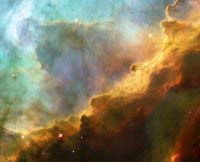A perfect storm of turbulent gases

Small region within Messier 17 (M17), a hotbed of star formation.
Like the fury of a raging sea, this anniversary image from the NASA/ESA Hubble Space Telescope shows a bubbly ocean of glowing hydrogen, oxygen, and sulphur gas in the extremely massive and luminous molecular nebula Messier 17.
This Hubble photograph captures a small region within Messier 17 (M17), a hotbed of star formation. M17, also known as the Omega or Swan Nebula, is located about 5500 light-years away in the Sagittarius constellation. The release of this image commemorates the thirteenth anniversary of Hubble’’s launch on 24 April 1990.
The wave-like patterns of gas have been sculpted and illuminated by a torrent of ultraviolet radiation from young, massive stars (which lie outside the picture to the upper left). The glow of these patterns highlights the 3D structure of the gases. The ultraviolet radiation is carving and heating the surfaces of cold hydrogen gas clouds.
The warmed surfaces glow orange and red in this image. The intense heat and pressure cause some material to stream away from the surface, creating the glowing veil of even hotter green-coloured gas that masks background structures. The pressure on the tips of the waves may trigger new star formation within them.
The image, roughly 3 light-years across, was taken on 29-30 May 1999, with Hubble’’s Wide Field Planetary Camera 2. The colours in the image represent various gases. Red represents sulphur; green, hydrogen; and blue, oxygen.
Media Contact
More Information:
http://www.esa.int/export/esaCP/SEM248R1VED_index_0.htmlAll latest news from the category: Physics and Astronomy
This area deals with the fundamental laws and building blocks of nature and how they interact, the properties and the behavior of matter, and research into space and time and their structures.
innovations-report provides in-depth reports and articles on subjects such as astrophysics, laser technologies, nuclear, quantum, particle and solid-state physics, nanotechnologies, planetary research and findings (Mars, Venus) and developments related to the Hubble Telescope.
Newest articles

Bringing bio-inspired robots to life
Nebraska researcher Eric Markvicka gets NSF CAREER Award to pursue manufacture of novel materials for soft robotics and stretchable electronics. Engineers are increasingly eager to develop robots that mimic the…

Bella moths use poison to attract mates
Scientists are closer to finding out how. Pyrrolizidine alkaloids are as bitter and toxic as they are hard to pronounce. They’re produced by several different types of plants and are…

AI tool creates ‘synthetic’ images of cells
…for enhanced microscopy analysis. Observing individual cells through microscopes can reveal a range of important cell biological phenomena that frequently play a role in human diseases, but the process of…





















